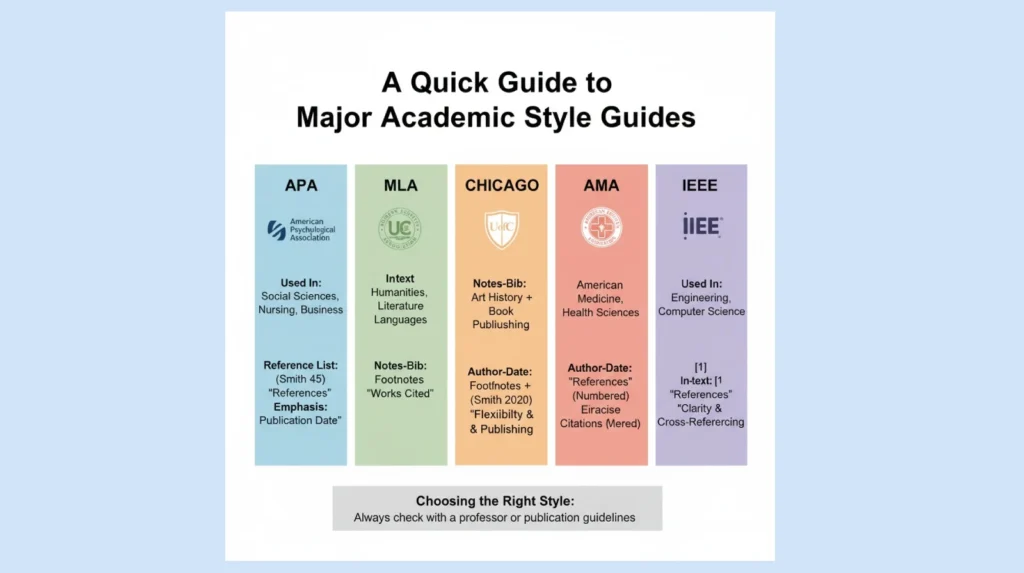In academic writing, citation and referencing styles are essential for maintaining credibility, avoiding plagiarism, and ensuring consistency. Different academic disciplines and journals follow specific style guides, each with its own rules for formatting, in-text citations, and reference lists. This article provides a simplified overview of the most commonly used academic style guides, along with links to their official resources.

1. APA Style (American Psychological Association)
The APA Style is primarily used in the social sciences, psychology, education, and related disciplines. It follows an author–date citation format and emphasizes clarity and precision in writing. Key features include a title page, abstract, running head, and a reference list at the end of the document.
- Used in: Psychology, Education, and Social Sciences
- In-text citation example: (Smith, 2022)
- Reference example: Smith, J. (2022). *Understanding human behavior*. Academic Press.
- Official link: https://apastyle.apa.org/
2. MLA Style (Modern Language Association)
The MLA Style is widely used in the humanities, particularly in fields such as literature, philosophy, and cultural studies. It emphasizes concise in-text citations and a detailed Works Cited page. Unlike APA, MLA uses page numbers in its citations.
- Used in: Literature, Humanities, and Cultural Studies
- In-text citation example: (Smith 45)
- Works Cited example: Smith, John. *Modern Poetic Forms*. Oxford University Press, 2022.
- Official link: https://style.mla.org/
3. Chicago Manual of Style
The Chicago Manual of Style (CMOS) is versatile and used across many disciplines, especially in history and the arts. It offers two documentation systems: (1) Notes and Bibliography—commonly used in humanities—and (2) Author–Date—preferred in social sciences. Chicago style is known for its flexibility and detailed formatting guidelines.
- Used in: History, Arts, and Publishing
- Citation systems: Notes & Bibliography, Author–Date
- Example (Notes): 1. John Smith, *The Renaissance Mind* (New York: Routledge, 2022), 45.
- Official link: https://www.chicagomanualofstyle.org/
4. Harvard Referencing
The Harvard referencing style is one of the most widely used systems in academic writing, particularly in UK, Australian, and international universities. It follows an author–date system similar to APA but offers more flexibility. Harvard referencing is straightforward and adaptable across disciplines.
- Used in: Multidisciplinary academic writing
- In-text citation example: (Smith, 2022)
- Reference example: Smith, J. (2022) *Research Methods in Education*. Cambridge University Press
- Official link: https://www.chicagomanualofstyle.org/
5. IEEE and Vancouver Styles
Both IEEE and Vancouver styles use numbered citation systems, making them ideal for technical, engineering, and medical fields. Instead of the author–date system, citations appear as numbers in brackets within the text, corresponding to a numbered reference list.
IEEE Style
- Used in: Engineering, Computer Science, and Technology fields
- In-text citation example: [1]
- Reference example: [1] J. Smith, “AI in Modern Computing,” *IEEE Transactions on Computers*, vol. 70, no. 3, pp. 120–128, 2022
- Official link: https://www.chicagomanualofstyle.org/.
Vancouver Style
- Used in: Medicine, Health Sciences, and Clinical Research
- In-text citation example: [1] or (1)
- Reference example: 1. Smith J, Brown T. Advances in clinical pharmacology. *Med J Health Res*. 2022;10(2):123–131
- Official link: https://www.chicagomanualofstyle.org/.
Conclusion
Choosing the right citation style depends on your field of study, target journal, or institutional requirements. While APA, MLA, Chicago, Harvard, IEEE, and Vancouver styles each have unique rules, their purpose remains the same—to ensure proper credit, consistency, and clarity in academic communication. Always consult the official guide or your journal’s instructions before submission to maintain accuracy and professionalism.
